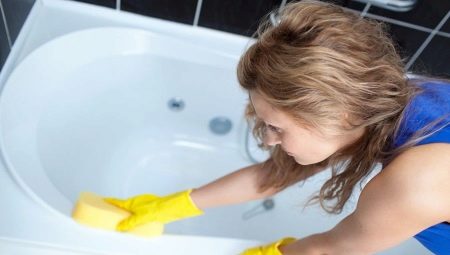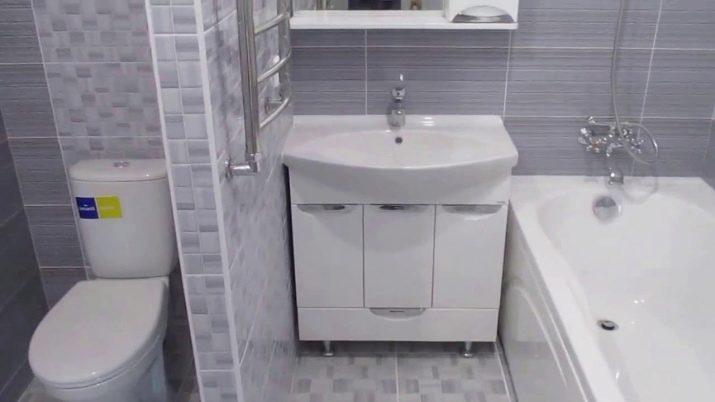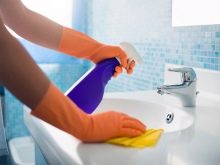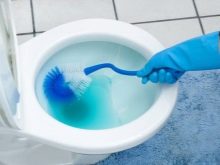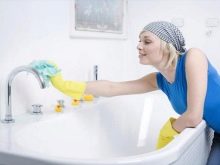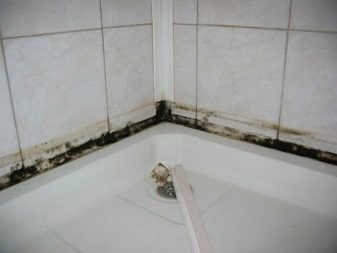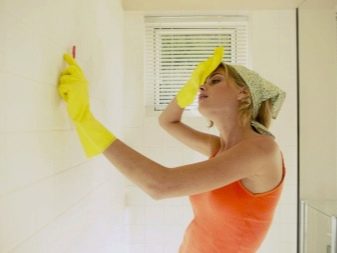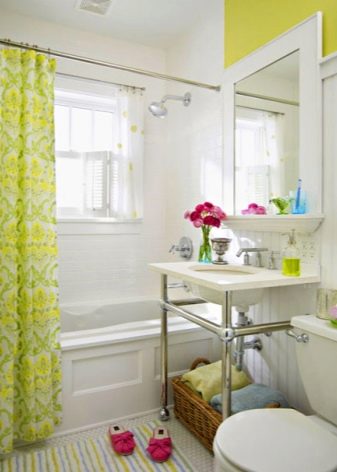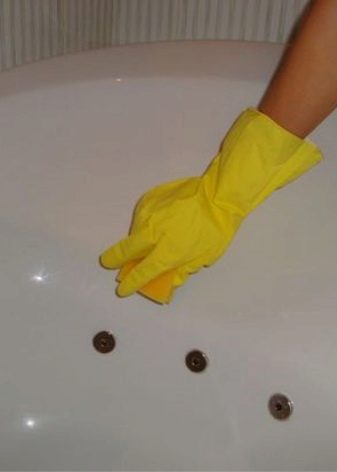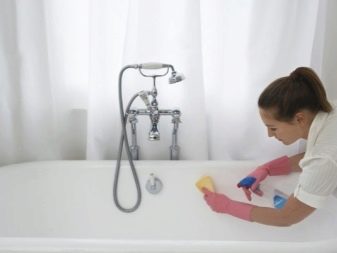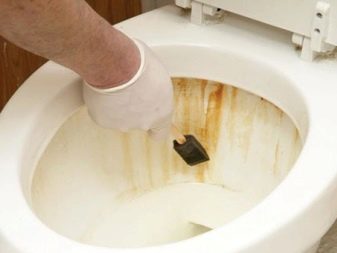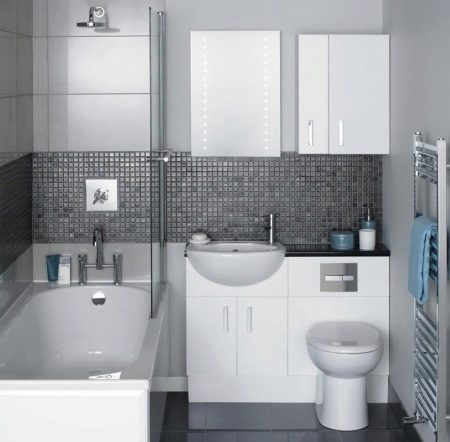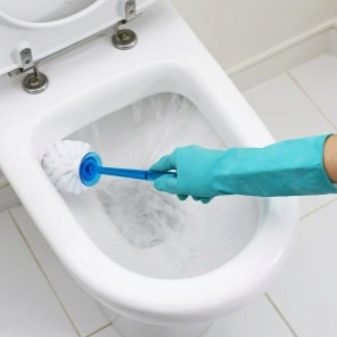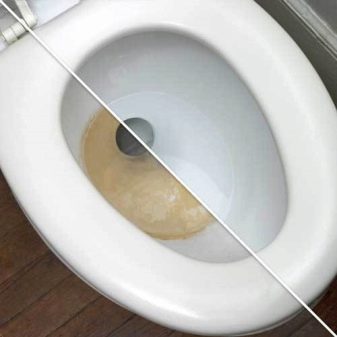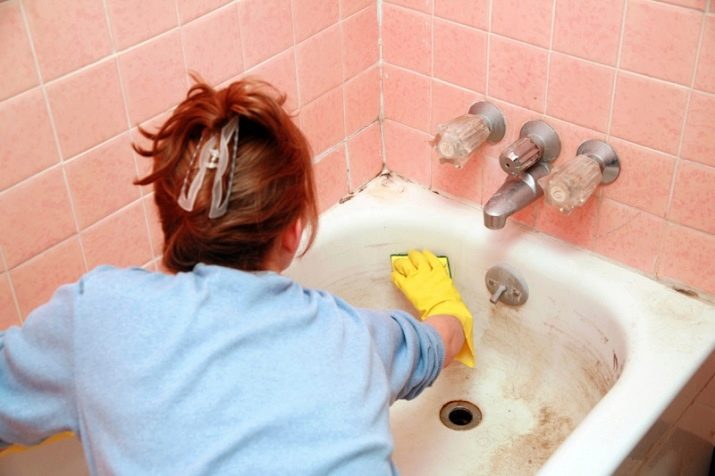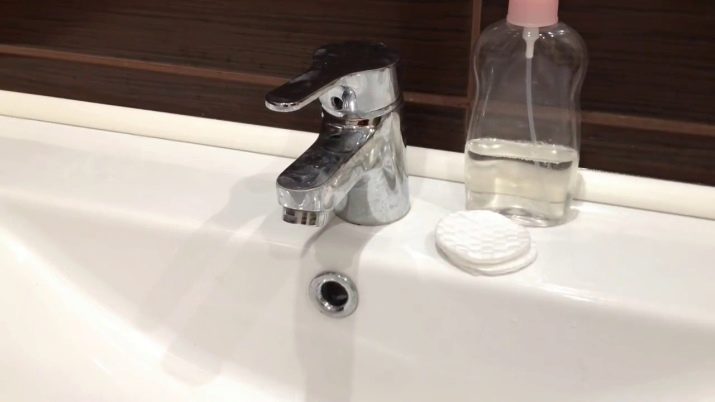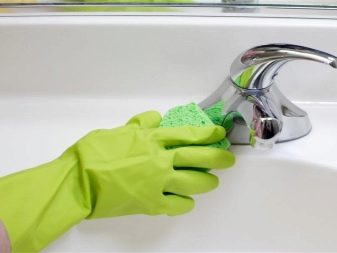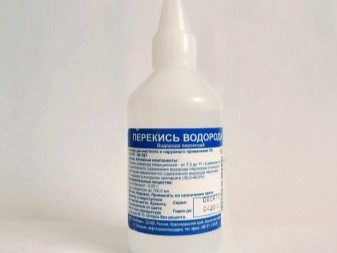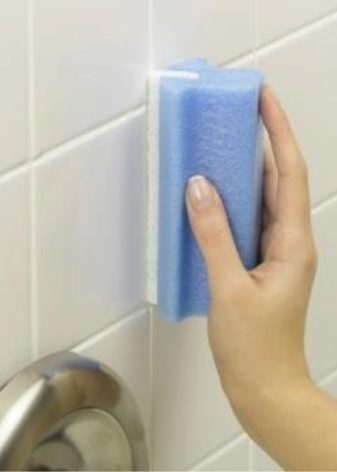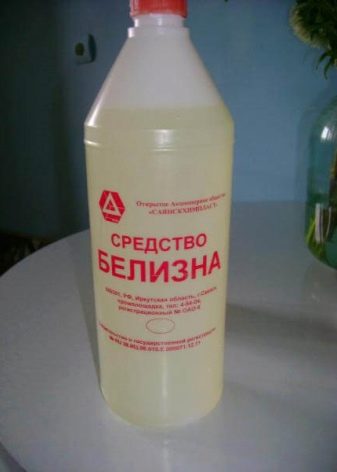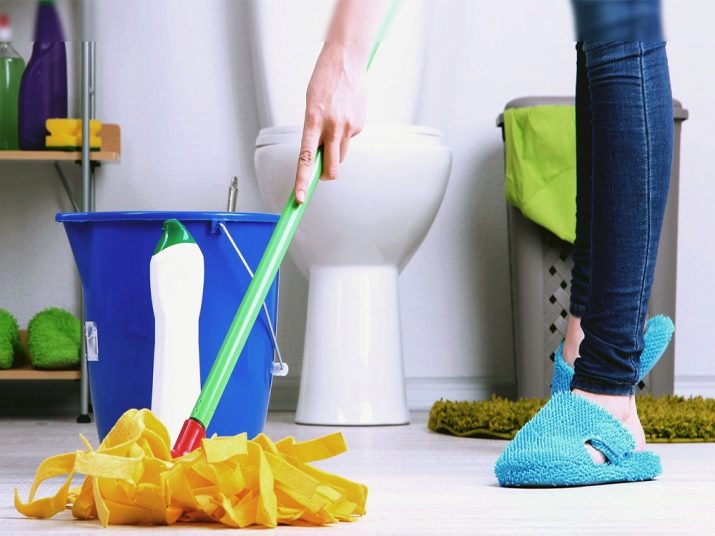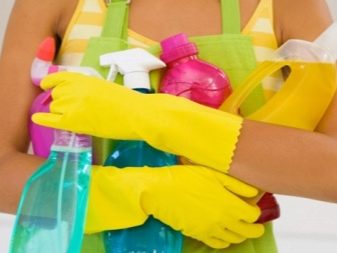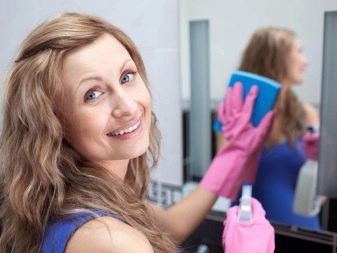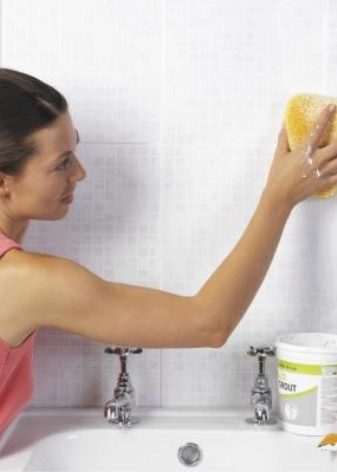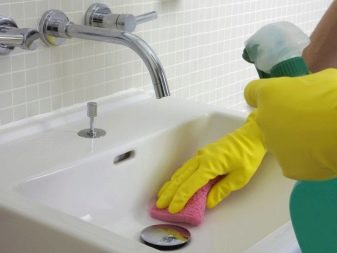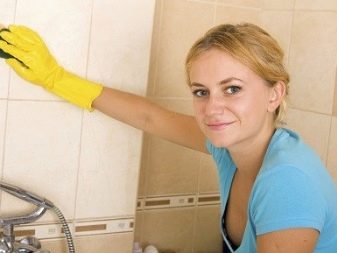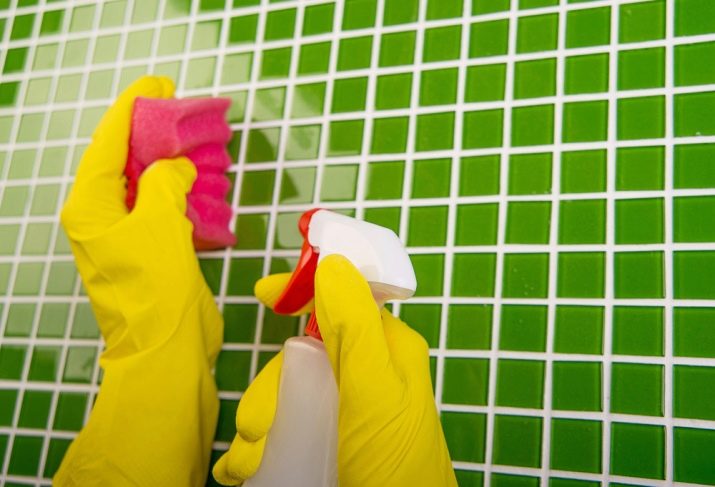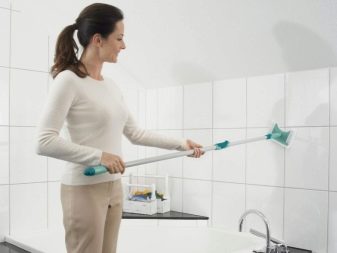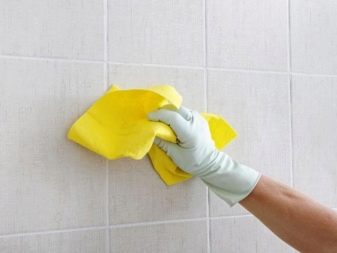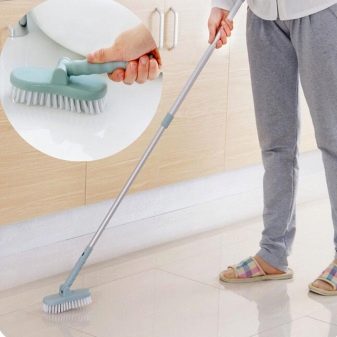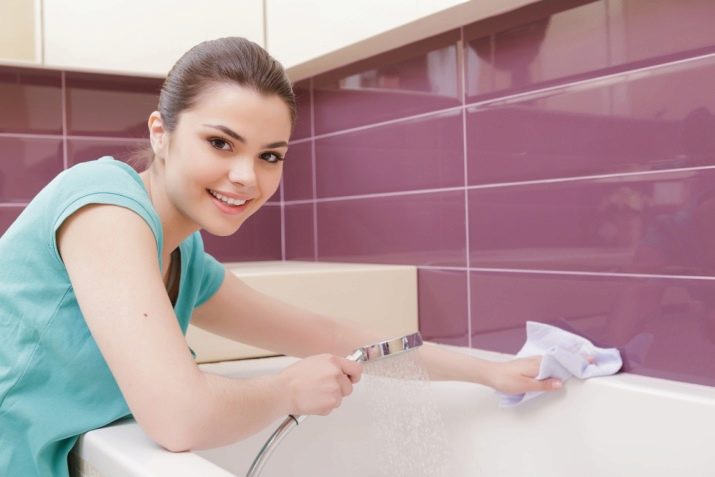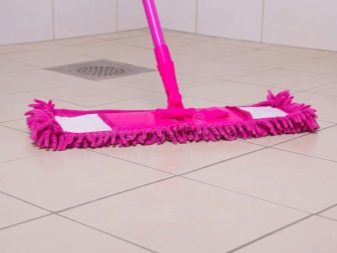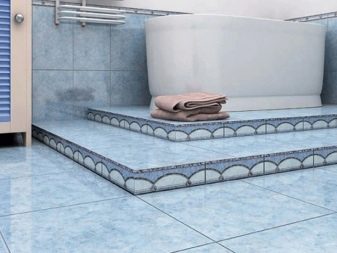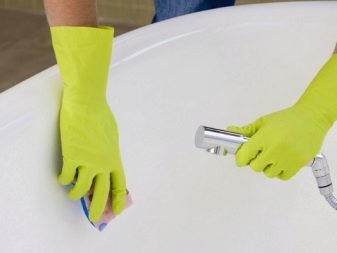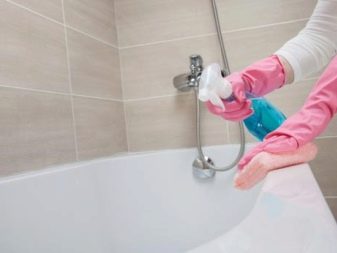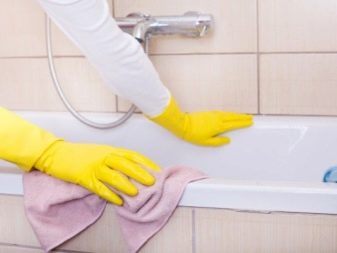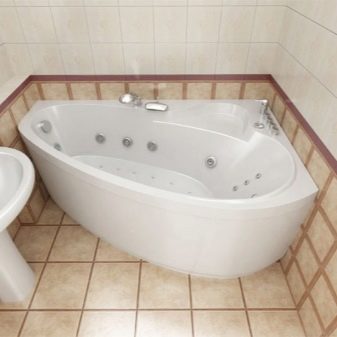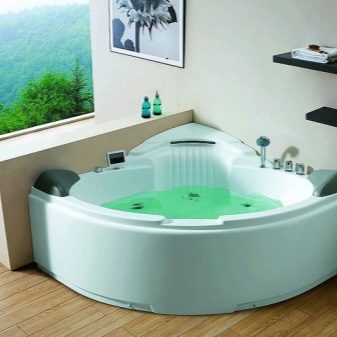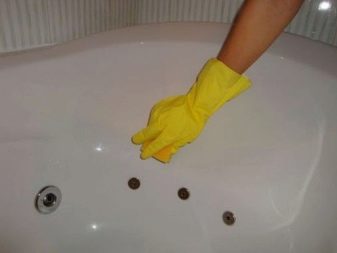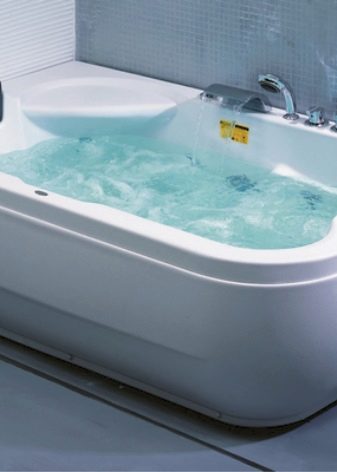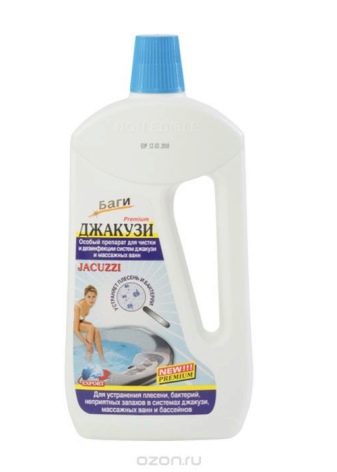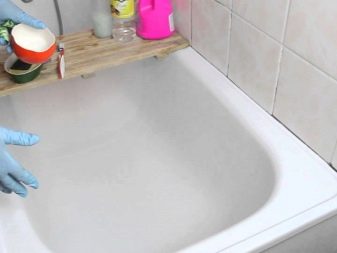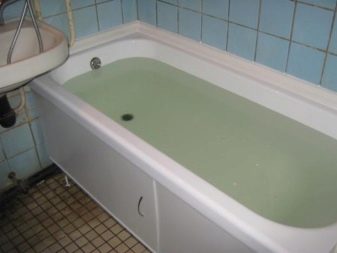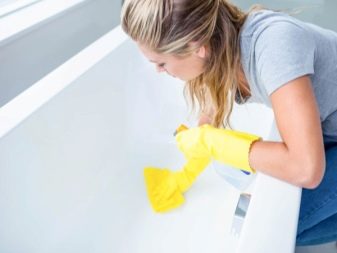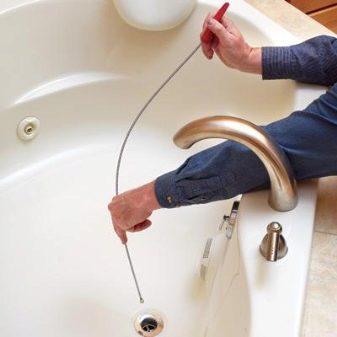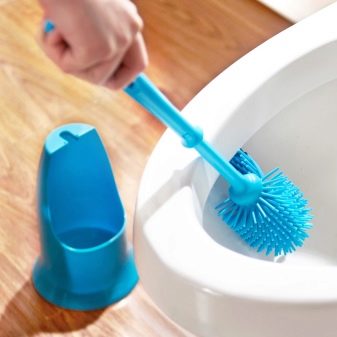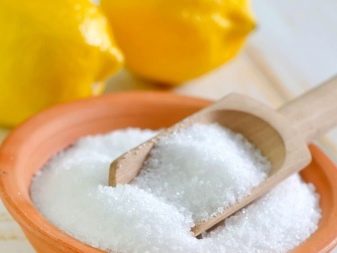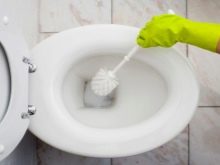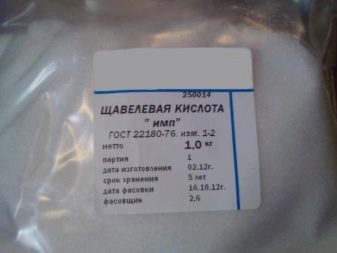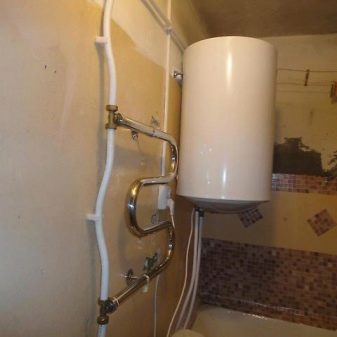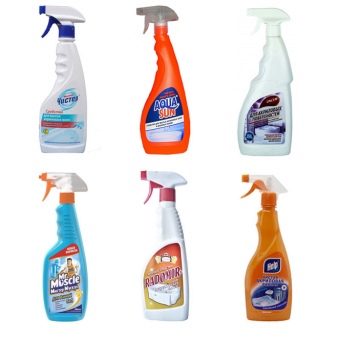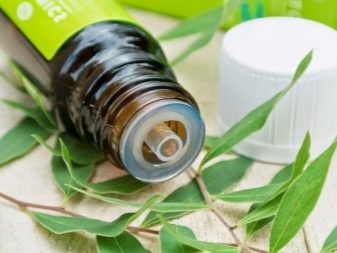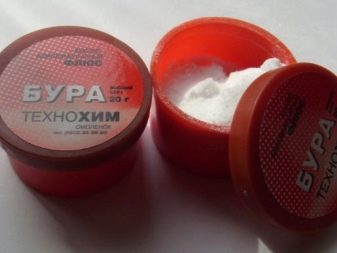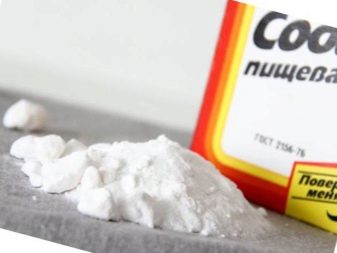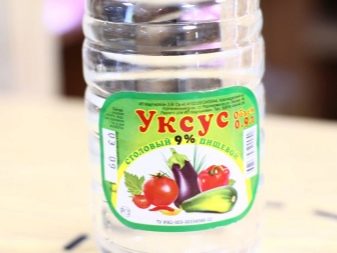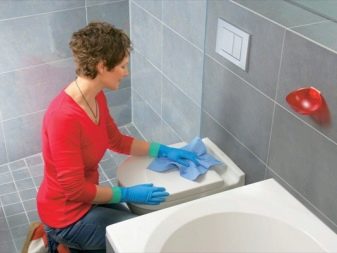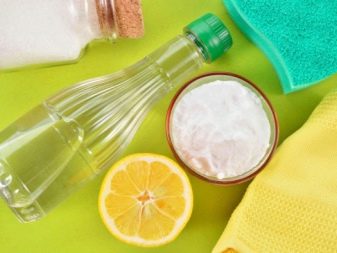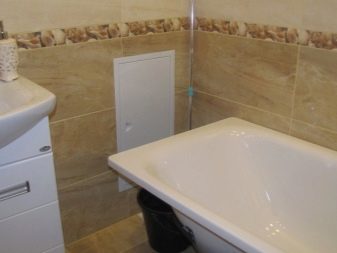The bathroom needs regular maintenance, since the increased air temperature and humidity contribute to the constant formation of various types of pollution. The ability to quickly and efficiently clean up the bathroom will greatly facilitate the cleaning process. It is important to know some tricks that will help not only cope with existing pollution, but also maintain cleanliness in the room for a long time. Effectively clean the bathroom to shine without much difficulty and high costs.
What are the pollution?
Bathroom needs constant maintenance of cleanliness. When cleaning the easiest to cope with the usual pollution, the cause of the formation of which is most often a soapy coating and dead skin. To remove such dirt, it is enough to wash it off with water immediately after the appearance. Stubborn dirt is more difficult to dispose of, and can also harm not only various surfaces and plumbing, but also human health.
One of the most unpleasant and dangerous types of pollution is mold.
The most common mold appears on the joints of tiles or on surfaces treated with sealant. The fungus significantly spoils the appearance of the room, and can also adversely affect the health of the household. The waste products of mold, which enter the human body by airborne droplets, are toxic. Such pollution can cause the following diseases:
- allergic reactions;
- asthma;
- candidiasis.
The cause of the fungus in the bathroom can serve as various factors. Mainly affects the appearance of mold:
- High humidity in the room. After washing or taking water procedures on various surfaces (ceiling, walls, tile joints, cast iron pipes) condensation is formed, which significantly affects the level of humidity. Often in the bathroom having problems with plumbing. Leaking taps also increase humidity.
- Poor ventilation or lack of it. If the ventilation duct is clogged or has holes that are not large enough, the air circulation is disturbed and no moist air leaves the room. A permanently closed bathroom door also prevents good ventilation.
- Lack of natural light. The window in the bathroom can only boast some owners of private houses. Most often the bathroom is not available for penetration of sunlight. Ultraviolet radiation prevents the occurrence and spread of fungus, as it has a detrimental effect on it. The lack of sunlight creates favorable conditions for the formation of mold.
One of the most common types of bath pollution is yellowing. The reason for the appearance of yellow bloom on plumbing are various chemical impurities that are contained in water. The water entering our house through worn-out communication systems is filled with particles of rust and various salts. These substances and provoke the formation of yellow plaque on the surface of the plumbing.
Yellow stains appear mainly near the drain or in places even if a small but constant accumulation of water (an example is a soap dish). It is recommended to regularly clean the enamel from the appeared yellowness.Cleaning plumbing from stagnant yellow bloom is a much more difficult task.
Poor water causes another type of pollution in the bathroom. Salts of magnesium and calcium, which are found in large quantities in water, are deposited on surfaces, which leads to the formation of lime scale. Removing limestone is more difficult than removing yellow stains. Worst of all amenable to cleaning the surface of the sink, bathtub and toilet. Regular hygienic care of plumbing helps to prevent the formation of lime deposits.
If you do not promptly clean the bathroom of yellowness and lime scale, it can lead to the formation of rust. A rusty patina may appear in the sink, bathroom, on the surface of the toilet bowl, on metal taps and pipes. So you do not have to wrestle with how to clean rust in the bathroom with a particular surface, It is necessary to follow a few simple rules:
- do not leave metal objects in the bathroom or sink;
- it is necessary to timely eliminate the leakage of the toilet bowl, faucets and pipes;
- always keep the bathroom clean;
- in the case of rust stains, it is recommended to immediately get rid of pollution.
Pollution on the surface of the plumbing is not only water. A common problem is the accumulation of urinary stone on the walls of the toilet bowl. Urinary stone is formed due to the irregular care and improper use of plumbing.
Preventing the formation of plaque will allow timely cleaning of the surface of the toilet bowl, also do not need to forget about the regular pressing of the drain button.
How to wash?
Before you start cleaning the bathroom, you need to decide how you will remove this or that pollution. The choice will depend entirely on the type of contamination and the type of surface to be cleaned.
To clean the chrome-plated faucet, special gels for chrome-plated surfaces will best help. If necessary, you can handle the mixer with dishwashing detergent, lemon juice, salt, soda and vinegar.
Lime deposits on the chrome surface can be removed with vinegar. To do this, just wipe the mixer with a soft cloth dipped in essence. With a long-term bloom soda will help to cope. To do this, rub the faucet with a toothbrush. To avoid the formation of plaque on the product, it is enough to wipe the chrome-plated surface once a day with a dry cloth.
The limescale on the mixer will help remove the Coca-Cola. The composition of cola contains acids that help to cope even with the old lime formations. Coke can be cleaned not only the faucet, but also a bath, sink and toilet, just wipe the contaminated surface with a sponge dipped in this drink. There are additional advantages to using Coca-Cola as a cleaning agent:
- when applying the liquid to the contaminated surface it is not necessary to wear gloves;
- Cola does not have a sharp unpleasant odor that must be weathered out of the room;
- such a tool will not harm the enamel, so it is suitable for cleaning new plumbing.
Citric acid can clean cast iron baths. To do this, you need to take hot water in the bath and pour 200 grams of citric acid there. Leave the bath with the resulting solution overnight. Apply citric acid to wash other surfaces with great care.
Rust in the bathroom and toilet can be removed with hydrogen peroxide. To do this, prepare a solution of 150 ml of ammonia and 50 ml of peroxide, apply to the contaminated surface and stand for twenty minutes. Peroxide also copes with mold. To remove the fungus, it is necessary to treat the affected areas several times with undiluted peroxide.
"White" is an excellent disinfectant. "Whiteness" can be processed tile joints from the mold. First, it is recommended to remove the mold mechanically, cleaning it from the seams. Then, using a brush, “Whiteness” is applied on the treated areas.
It is not necessary to wash the product out of the seams - “Whiteness” should be completely absorbed.
How to clean different types of surfaces in the bathroom?
By cleaning the bathroom must be approached with all responsibility. Incorrectly chosen cleaning agent can damage the enamel of the bath, the chrome-plated coating of the mixer or various mirror surfaces. It will not be difficult to wash the bathroom completely; one has only to take into account the peculiarities of cleaning various types of surfaces.
In addition to basic plumbing items, as well as the floor and ceiling, additional products that are in the bathroom need to be cleaned. In addition to observing the rules of cleaning different types of surfaces, It is important to consider the order in which to clean the room:
- ceiling and lighting devices;
- walls;
- glass surfaces and mirrors;
- shelves, cabinets and other furniture;
- plumbing items;
- floor.
To remove dirt and accumulated dust from the lighting devices, it is enough to wipe the surface of the products with a damp cloth. A very dirty inner and outer surface of the ceiling lamps will not be enough to just wipe with a napkin. If possible, the ceiling lamps should be removed and rinsed in water with the addition of liquid soap or dishwashing detergent. Then the product should be rinsed under a stream of warm water, wiped with a dry clean cloth and leave for some time on a clean, flat surface until completely dry.
Mirrors and glass surfaces should be cleaned with great care. In addition to the fact that such a material is sensitive to mechanical damage, after cleaning there are often stains on it. To wash the mirror without divorce, you should follow the following algorithm:
- First of all, it is necessary to remove dirt, soap spots and limescale. To do this, you can use both special cleaners and dishwashing gel dissolved in water. Wash the surface with a soft cloth or a soft sponge.
- The remnants of the cleaning agent remove a damp clean sponge.
- Spray on the mirror surface window cleaner. Rub the mirror with a microfiber cloth or newspaper to shine. If you did not have the means for windows or mirrors, you can make an analogue of your own at home. To do this, one tablespoon of ammonia must be mixed with one glass of water. In the resulting solution, you can add a tablespoon of vodka or medical alcohol.
Glass shelves in the bathroom can be washed in the same way as mirrors. To get rid of dirty stains on the cabinet, lockers or other furniture, just wipe the surface with a damp cloth with dishwashing detergent.
To a special type of surface can be attributed the joints of tiles and silicone sealant, which is often used when installing plumbing in the bathroom. Such places are most susceptible to mold. Get rid of mold on the sealant will help any bathroom cleaner, diluted in warm water. The sponge soaked in the solution is used to treat the affected areas. After surface treatment, the remnants of the solution and mold must be washed off.
To prevent the re-formation of the fungus, the treatment sites must be disinfected. Bleach can be used as a disinfectant. Bleach should be applied to the sealant and leave for 15 minutes, then carefully wipe with a brush. The remains of bleach must be washed off, and then wipe the silicone dry.
If after careful processing of silicone sealant mold appears again, you will have to resort to radical measures to eliminate the fungus.The reason for the reappearance in this case lies in the center of the spread of mold, which is under the sealant. In this case, with the help of a knife it is necessary to remove the old layer of silicone sealant.
After removing the silicone, the seam must be thoroughly cleaned and treated with a disinfectant.
Isopropyl alcohol can be used for disinfection. Alcohol must be poured into the seam and left for half an hour. After that, the seam must be wiped with a dry cloth and left to dry completely for a day. A fresh layer of sealant is applied to the treated surface.
Different surfaces in the bathroom sometimes have to be cleaned not only from dirt, lime, rust and mold, but also from various coloring compounds. You can wipe off Zelenka from almost any surface with ordinary alcohol. Hydrogen peroxide will help wash away stains from potassium permanganate.. Peroxide must be mixed with citric acid in the ratio of one to one. The solution is applied to contaminated areas for 5 minutes, then washed off with water.
There is a more efficient and faster way to remove traces of potassium permanganate. It also needs hydrogen peroxide. The second cleaning component will be acetic essence. To prepare the solution in this case is not required. First, polluted areas are wiped with peroxide and then with vinegar until the spots completely disappear.
Wall and ceiling surfaces
The tile is one of the most popular materials used for finishing of bathrooms. Without proper care, the tile eventually becomes covered with limescale, and mold appears in the seams. Therefore, the tile needs regular maintenance.
Suitable cleaning agent can be purchased at any household chemical store. For washing the tile is not recommended to use powders., because after them on the surface of the tile may remain scratches. Chlorine-containing agents are allowed. Chlorine helps to cope with limestone stains and rust. Suitable also means for washing windows and mirrors, which includes ammonia.
It is not necessary to buy special detergents to clean ceramic tiles. A regular soap solution is suitable for regular maintenance, provided that there is no lime and rust on the tile.
To eliminate heavy pollution, you can use 6% vinegar. Vinegar should be sprayed onto the tile and left for a while. Then contaminated areas need to be rubbed with a brush. After the surface has been treated, residues of vinegar are removed from the wall with a damp cloth. Clean tiles are wiped with a microfiber cloth.
To restore the tile shine will help liquid ammonia. In two liters of water it is necessary to dissolve a tablespoon of ammonia. The solution is sprayed onto the walls and left for 5 minutes. Then the tile must be wiped with a damp cloth. After the remnants of liquid ammonia solution are removed, the wall must be wiped dry.
The floor of the tile, in addition to regular cleaning, requires constant disinfection, as it is more susceptible to contamination and the rapid spread of bacteria than the walls and ceiling. Necessary tools for washing and disinfection can be made by hand. This will require:
- four tablespoons of salt;
- four tablespoons of soda;
- 100 ml of alcohol;
- 4 liters of water.
For the decoration of the walls and the ceiling in the bathroom often use PVC panels. Plastic panels are much cheaper than other finishing materials. In addition, plastic is resistant to moisture and is not afraid of water.
To clean plastic panels do not use metal sponges or hard brushes (they may scratch the surface). The temperature of the water used during cleaning should not exceed 40 degrees.. Cleaners must have a liquid or gel-like structure (powders must be discarded).
In addition to special store cleaning products, you can use solutions prepared by yourself.The simplest option is based on laundry soap or dishwashing gel. You can also wipe plastic panels with vinegar or vodka.
If yellowness appeared on the PVC panels, chlorine bleach will help to cope with it. Three tablespoons of bleach must be diluted in 10 liters of water. With a soft brush dipped in solution, remove the yellowness.
To clean the plastic panels on the ceiling you need to use a special mop. The surface can be treated with soapy water or alcohol-containing agents (there will be no streaks on the ceiling).
Bathtub
Bathing newborn babies requires a separate bath, which cannot be used for any other purpose. Baby's skin is very delicate and sensitive to various stimuli. Baby bath should be regularly cleaned from various kinds of pollution and disinfected.
Regular chemical detergents and powders are not recommended, as they can cause an allergic reaction in a child. Modern manufacturers are ready to offer special tools designed specifically for children. These cleaners do not contain dyes, have antibacterial properties and do not cause allergies.
New bathroom before the first bathing must be disinfected. To do this, you must first wash the bath with baby soap, and then pour over boiling water. For the subsequent disinfection most often use soda. Baking soda is applied to a wet sponge and treated bath.
After each treatment, it is important to carefully remove any soda residue from the surface of the product.
The bath with hydromassage, in addition to regular cleaning, needs periodic disinfection. The special feature of cleaning a jacuzzi is that, in addition to the tank, it is also necessary to clean the internal parts of the hydromassage system. The bowl of such a product can be made of the following materials:
- cast marble;
- ferrous metals (steel and cast iron);
- acrylic.
Products from cast marble and ferrous metals are easy to maintain. There is no need to buy special detergents for surface treatment. The tank is cleaned with ordinary soap solution. Acrylic bath detergents can be used to remove heavy dirt.
The acrylic hot tub needs to be cleaned with extreme care. Such material is sensitive to mechanical stress. Metal brushes and other coarse materials can ruin the enamel. It is not allowed to use various types of solvents for cleaning.
Suitable detergents should have a gel or foam structure. Powdered cleaners can damage acrylic. To care for the acrylic surface, they produce special products for washing, so there is no need to clean this bath using traditional methods. To keep the bath clean You can periodically wash the surface with liquid soap.
The process of cleaning and disinfecting a hot tub of any material is as follows:
- The tank is filled with hot water ten centimeters above the nozzles.
- A special detergent or dishwashing gel is added to the water.
- The maximum pressure level is set and the hydromassage system is activated for fifteen minutes.
- Water should be drained and rinsed bath.
- The cleaning procedure must be repeated, but now with cold water and without the addition of cleaning agents.
Cast iron and steel baths are strong and durable, but the enameled coating of such products needs constant care. In order not to damage the enameled surface, it is worth refusing aggressive cleaning agents. Suitable cleaning products can be purchased at any household chemical store.
Not worse than the store tools with the task of removing dirt from the enamelled surface helps to cope with lemon juice. Cast iron bath is treated with lemon juice, incubated for ten minutes and rinsed with water.In the fight against severe contamination (rust or old limescale) will help expensive shop tools or a solution of ammonia and peroxide.
For cleaning and bleaching old cast iron baths, it is necessary to resort to more radical methods and aggressive means. After many years of plumbing service wear:
- mechanical damage occurs;
- bath loses its original brilliance;
- the surface is covered with lime and rust.
When cleaning the old bath with cleaning products, one no longer has to fear that the product will deteriorate. To remove rust, you can use an iron brush and oxalic acid. The main rust layer must be brushed off. Then a mixture (in the form of a paste) of oxalic acid and water is applied to the contaminated areas for half an hour. After treatment, the oxalic acid paste must be washed off.
The easiest way to clean an old bath is to treat it with any abrasive detergent. Places of accumulation of strong plaque and rust should be rubbed with an iron brush. Instead of household chemicals, you can use soda.
Plumbing and pipes
Chrome-plated taps are easiest to clean with special products for this type of coating. Instructions for the correct use of the cleaning agent can always be found on the product label. Before buying a cleaning agent, you should consider some of the nuances:
- Means for washing sinks, bathtubs, toilet bowls, as well as rust removers and various bleaches cannot be used. After being treated with such agents, dark stains may form on the chrome plating.
- Powdered detergents can damage the chrome finish, creating small scratches on it. The choice is to be made in favor of gels, as well as liquid and foamy agents. If contamination of the chrome surface is insignificant, they can be scrubbed with dishwashing gel.
- Do not mix different chemical cleaners.
Baking soda or citric acid can give an initial shine to the mixer and tap. To do this, you must carefully treat the surface with a sponge dipped in a solution of citric acid or sprinkled with soda.
The sink from any material in a bathroom can be cleared by means of universal cleaners for bathroom equipment. Water stains can be wiped off with alcohol or vinegar. Contamination on the surface of a sink made of artificial stone can be removed with toothpaste or a slurry of soda and water.
In order to clean the toilet from urinary stone and limescale, you can buy ready-made tools intended for this purpose. Cleaning products for washing the toilet differ in composition:
- acidic;
- alkaline;
- based on chlorine.
High concentrations of old contaminants can be handled by high-concentration acids:
- The electrolyte used for batteries. Cannot be used if sewage pipes are made of plastic.
- Oxalic acid powder.
- Monochloride iodine. Removes all types of stone and rust. Cannot be used if sewage pipes are made of cast iron.
- Hydrochloric acid. Removes all stone types.
With time, rust and lime deposits appear on the surface of metal pipes. Before complete removal of rust formations, the pipe must be machined. Rust is scraped off with sandpaper or a metal brush. Then the outer surface of the pipe must be processed in one of the following ways:
- A solution of vinegar and citric acid in a ratio of 1 to 1 should be applied to areas previously treated with sandpaper, and leave for a couple of hours. Wash off the solution with soapy water.
- Two tablespoons of baking soda should be mixed with 1/3 cup of water. Apply the mixture for 15 minutes. Wash off with water with a few drops of vinegar.
- Special tools.
Folk councils
In the fight against mold formed on silicone sealant or other surfaces, not only expensive cleaning products can help. Popular recipes tested by time, no less effectively cope with this type of pollution. It will not be difficult to clean the silicone from fresh mold - it is enough to wash the fungus and treat the surface with an antiseptic. To cope with the old mold will be much more difficult. Consider some effective methods of fighting fungus in the bathroom:
- Tea tree oil (one teaspoon) must be diluted in a glass of water at room temperature. With a solution of the essential oil to treat the problem area. After surface treatment, it is not necessary to flush the applied solution. Tea tree oil has antiseptic properties that help prevent the re-formation of mold.
- In two and a half liters of water must be diluted with one glass of borax. With the help of a toothbrush moistened with a solution, the areas affected by mold are wiped. After processing there is no need to rinse the solution off the surface. Such impregnation forms a protective layer against the fungus.
- Half a teaspoon of baking soda is required to be diluted in 500 ml of warm water. The solution is rubbed into the moldy area using a brush. If necessary, the treatment must be carried out several times. After removing the fungus, the solution must be washed off.
- The surface covered with mold can be treated with ordinary undiluted vinegar. After one hour, the vinegar must be removed with a damp sponge.
There is a universal tool for cleaning almost all types of surfaces in the bathroom. This tool can handle mixers, ceramic tiles and sanitary ware. To prepare such a solution and clean it contaminated surface can be as follows:
- Vinegar (one cup) must be heated on the stove. Boiling vinegar is not necessary. The temperature of the fluid should be such that you can put a finger in it and not burn yourself.
- In the spray gun with the help of a funnel, you need to pour heated vinegar and a glass of dishwashing liquid. Dishwashing detergent can be replaced with liquid soap.
- The resulting mixture should be well shaken.
- Spray the solution onto the surface to be cleaned. Further, it is necessary to evenly distribute the cleaning agent over the surface with a sponge and leave for half an hour.
- The solution must be completely washed off.
Anti-slip bath cover requires special care and care in cleaning. Wrong choice of means for washing of a bathtub from acryle can spoil the enameled surface.
Limescale can be removed with the help of available tools such as vinegar or lemon juice. The lime-covered area should be treated with the selected agent and wait twenty minutes. Then vinegar or lemon juice should be washed off with warm water.
The old cast-iron bath with patina and rust can be cleaned with ammonia. First, the surface of the bath must be treated with hot water. To do this, it is enough to dial boiling water into it and leave it for 15 minutes, after which the water must be drained. Then the bath is treated with ammonia. Nadyatryu need to give some time to soak.
After half an hour, soda is applied to the surface (can be replaced with laundry detergent). Use a hard sponge or an iron brush to rub the contaminated areas intensively. After cleaning, wash the soda and dirt with water.
To wash your bathroom quickly and to shine, see the video below.
